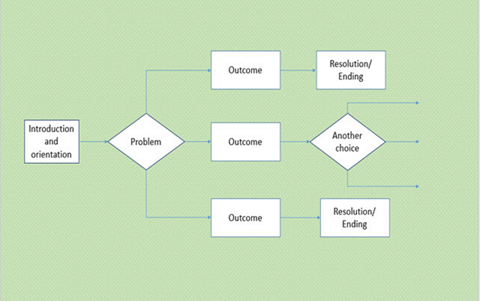Plan a 'choose your own adventure' story

About this lesson
Students create a storyboard to plan a ‘choose your own adventure' story, where the reader is provided with a number of decisions that lead to alternative endings.
Year band: 3-4
Curriculum Links AssessmentCurriculum Links
Digital Technologies
Processes and production skills: Generating and designing
- Follow and describe algorithms involving sequencing, comparison operators (branching) and iteration
(AC9TDI4P02)
English
Creating literature
- Create and edit imaginative texts, using or adapting language features, characters, settings, plot structures and ideas encountered in literary texts (AC9E3LE05)
Creating texts
- Plan, create, edit and publish imaginative, informative and persuasive written and multimodal texts, using visual features, appropriate form and layout, with ideas grouped in simple paragraphs, mostly correct tense, topic-specific vocabulary and correct spelling of most high-frequency and phonetically regular words (AC9E3LY06)
- Create and edit literary texts by developing storylines, characters and settings (AC9E4LE05)
Digital Literacy
Managing and operating
- Manage content
- Protect content
- Select and operate tools
Creating and exchanging
- Plan
- Create, communicate and collaborate
- Respect intellectual property.
Assessment
Evaluate students’ understanding using a simple checklist. For example:
- The storyboard represents a sequence of events that follow a well-defined plot.
- The storyboard provides the reader with a choice of options leading to alternative endings.
- The interactive story is correctly hyperlinked directing the reader to the correct event within the plot.
- Navigation buttons have been used effectively
Suggested steps
- Read a ‘choose your own adventure' story to the class and model the construction of a storyboard to graphically portray the choices the reader encounters and the subsequent outcome of each choice. Explain that the concept of a choose your own adventure story is to allow the readers to choose different pathways leading to alternative events within the plot.
![]()
Additional scaffolding
To allow for multiple means of representation, you could also show a flowchart (like the one above) and have students come up with examples of a problem that could have three solutions.
Also, instead of a story, you could also model a familiar sequence like ‘How to enter the classroom’ or ‘How to make a pizza’ so that the task is a bit more familiar. Note: you may want to do the ‘choose your own adventure’ story later as it allows for multiple endings.
- Students explore the concept of decisions (branching) by planning and creating their own choose your own adventure story.
![]()
Working memory
You may wish to keep planning and decision making to simple Yes-No branching at the start, then add complexity as appropriate.
- Students use a storyboard to graphically display the plot, including all choices offered and alternative endings.
![]()
![]()
Additional scaffolding/ Having limited, low or no vision
To allow for multiple means of expression, students could do this activity on paper (A3 suggested), with physical blocks (rectangles and diamonds/squares), or using a computer word processing or slide presentation application.
- Students use the Hyperlink function within PowerPoint to create the interactive story. Branching options can be provided via buttons or symbols to support the reader to navigate their way through the plot.
![]()
Additional scaffolding
Perhaps have students work in pairs and/or share their stories as a form of debugging.
Discussion
- Invite students to share their interactive stories with their peers and discuss the alternative endings or variations to endings.
- List some of the choices the students have provided the readers as alternative pathways within the plot.
- Consider how some choices lead to a chain of events that are riskier than others?
- Explain that a choose your own adventure story can be likened to the concept of ‘branching’ or decision making where we can change our actions based on the value of data.
![]()
Extension
You can have students include programming language in their visual flowchart (e.g. “if yes then”, “else if”, and “while”).
- Ask students to consider the information they had to provide the reader to help them make their decision. Was there enough information provided to help them decide which path to take? Was it confusing at any point? Centre the discussion on data and ask student to suggest what data was needed to help readers make their decisions.
Why is this relevant?
Decisions are an important concept of computational thinking. They allow actions to be changed based on the value of data. Algorithms are the step-by-step procedures required for solving a problem. A storyboard depicting a choice of events within a plot is a fun way of visualising algorithms and can be an effective way to teach the concept of ‘branching’. Branching involves making a decision between one of two or more actions depending on sets of conditions and the data provided.
This activity can be used to strengthen students understanding of computer programming as a series of instructions that can change depending on different user inputs or conditions. The focus is on how computers follow instructional pathways.
Resources
Create a ‘choose your own adventure’ story.